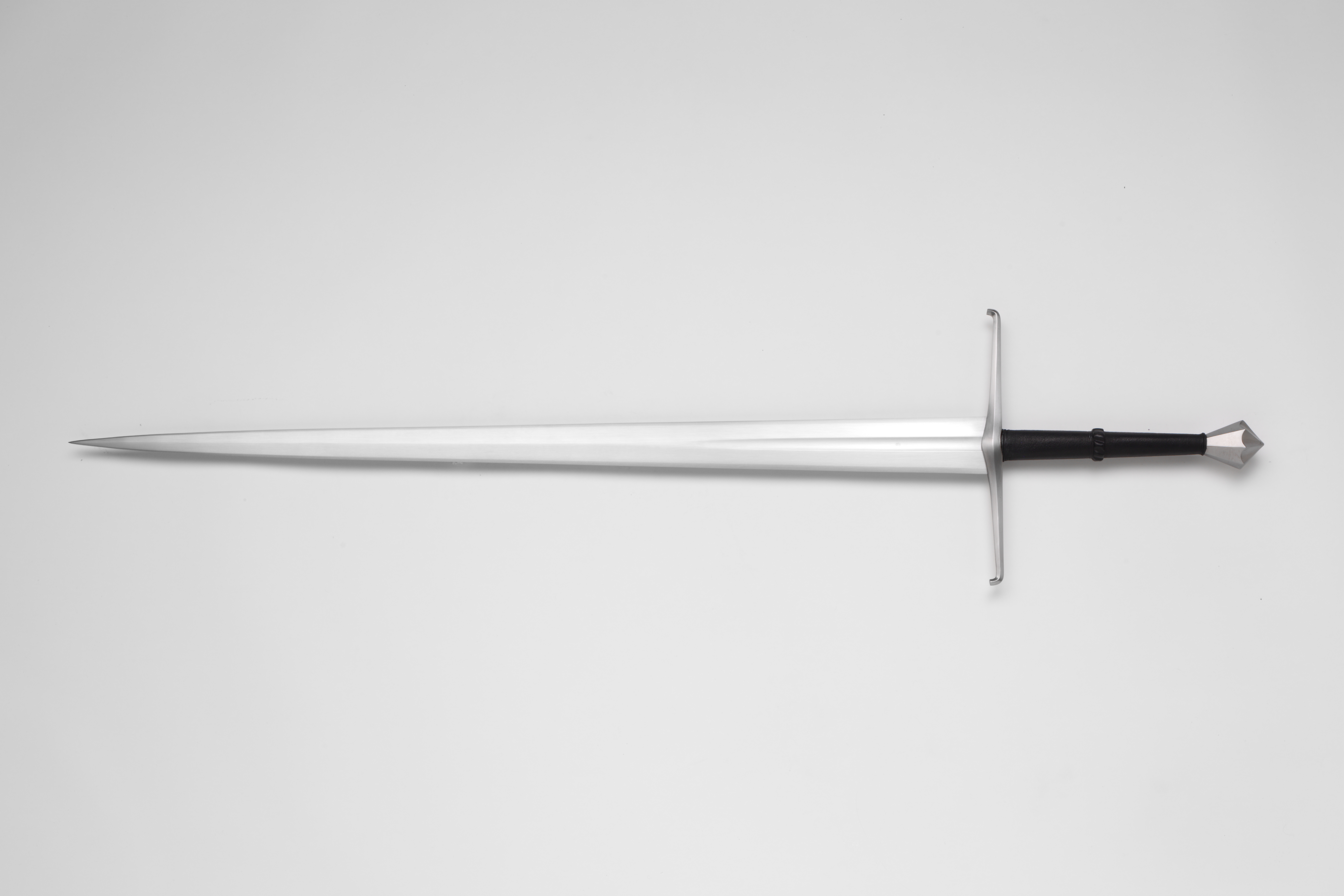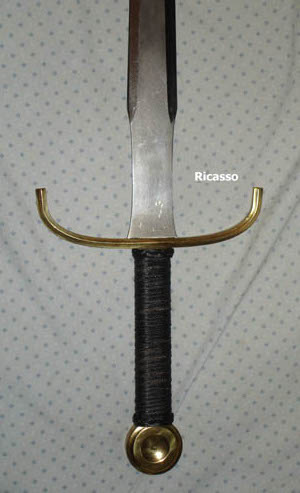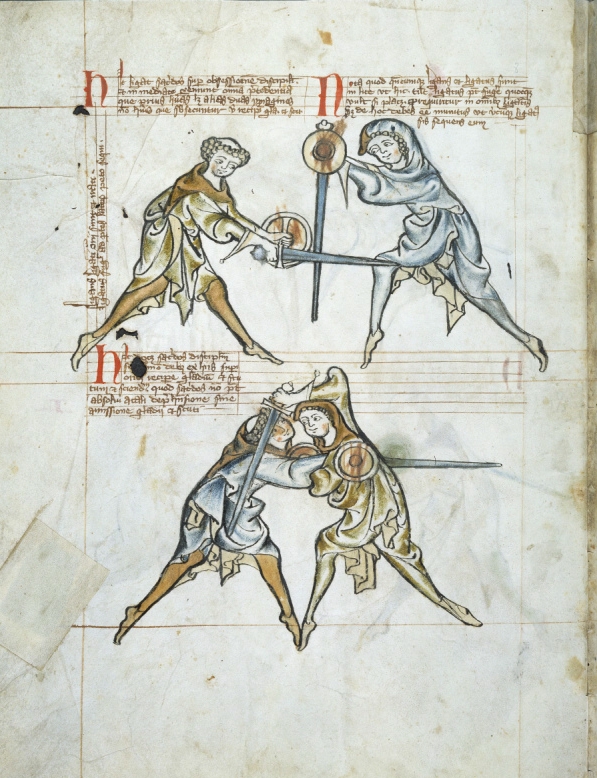|
Half-sword
Half-sword, in 14th- to 16th-century fencing with longswords, refers to the technique of gripping the central part of the sword blade with the left hand in order to execute more forceful thrusts against armoured and unarmoured opponents. The term is a translation of the original German ''Halbschwert''. The technique was also referred to as ''mit dem kurzen Schwert'', "with the shortened sword" in German. Half-sword is used for leverage advantage when wrestling with the sword, as well as for delivering a more accurate and powerful thrust. Both of these are critical when fighting in plate armour because a slice or a cleaving blow from a sword is virtually useless against iron or steel plate. Most medieval treatises show armoured combat as consisting primarily of fighting at the half-sword; the best options against an armoured man being a strong thrust into less-protected areas such as the armpits or throat or, even better, the same against a man who has already been cast to the ... [...More Info...] [...Related Items...] OR: [Wikipedia] [Google] [Baidu] |
Longsword
A longsword (also spelled as long sword or long-sword) is a type of European sword characterized as having a cruciform hilt with a grip for primarily two-handed use (around ), a straight double-edged blade of around , and weighing approximately . The "longsword" type exists in a morphological continuum with the medieval knightly sword and the Renaissance-era Zweihänder. It was prevalent during the Late Middle Ages, late medieval and Renaissance periods (approximately 1350 to 1550), with early and late use reaching into the 11th and 17th centuries. Names English The longsword has many names in the English language, which, aside from variant spellings, include terms such as "bastard sword" and "hand-and-a-half sword." Of these, "bastard sword" is the oldest, its use being contemporaneous with the weapon's heyday. The French ' and the English "bastard sword" originate in the 15th or 16th century, originally in the general sense of "irregular sword, sword of uncertain orig ... [...More Info...] [...Related Items...] OR: [Wikipedia] [Google] [Baidu] |
Ricasso
A ricasso is an unsharpened length of blade just above the guard or handle on a knife, dagger, sword, or bayonet. Blades designed this way appear at many periods in history in many parts of the world and date back to at least the Bronze Age—essentially, as long as humans have shaped cutting tools from metals. There were many reasons to make a blade with a ricasso, and in Europe, later longswords, claymores, rapiers, and other lengthy swords often had this feature. One very simple influence presently and historically is fashion, which often answers this question for blades where the presence or lack of a ricasso has no effect on how it is used. Leaving a ricasso can also save the blade maker's time—a section of blade that would not be used given the purpose of the piece does not have to be shaped and sharpened. In many cases, however, they are quite functional. Historically, ricassos were commonly present on medieval and early Renaissance swords. The basic function was to a ... [...More Info...] [...Related Items...] OR: [Wikipedia] [Google] [Baidu] |
Historical Fencing
Historical European martial arts (HEMA) are martial arts of European origin, particularly using arts formerly practised, but having since died out or evolved into very different forms. While there is limited surviving documentation of the martial arts of classical antiquity (such as Greek wrestling or gladiatorial combat), most of the surviving dedicated technical treatises or martial arts manuals date to the late medieval period and the early modern period. For this reason, the focus of HEMA is ''de facto'' on the period of the half-millennium of ca. 1300 to 1800, with a German, Italian, and Spanish school flowering in the Late Middle Ages and the Renaissance (14th to 16th centuries), followed by French, English, and Scottish schools of fencing in the modern period (17th and 18th centuries). Martial arts of the 19th century such as classical fencing, and even early hybrid styles such as Bartitsu, may also be included in the term HEMA in a wider sense, as may traditional ... [...More Info...] [...Related Items...] OR: [Wikipedia] [Google] [Baidu] |
Plate Armour
Plate armour is a historical type of personal body armour made from bronze, iron, or steel plates, culminating in the iconic suit of armour entirely encasing the wearer. Full plate steel armour developed in Europe during the Late Middle Ages, especially in the context of the Hundred Years' War, from the coat of plates (popular in late 13th and early 14th century) worn over mail (armour), mail suits during the 14th century, a century famous for the Transitional armour, in that plate gradually replaced mail. In Europe, full plate armour reached its peak in the 15th and 16th centuries. The full suit of armour, also referred to as a panoply, is thus a feature of the very end of the Middle Ages and the Renaissance period. Its popular association with the "Middle Ages in popular culture, medieval knight” is due to the specialised jousting armour which developed in the 16th century. Full suits of Gothic plate armour and Milanese plate armour were worn on the battlefields of the Burgu ... [...More Info...] [...Related Items...] OR: [Wikipedia] [Google] [Baidu] |
German Language
German (, ) is a West Germanic language in the Indo-European language family, mainly spoken in Western Europe, Western and Central Europe. It is the majority and Official language, official (or co-official) language in Germany, Austria, Switzerland, and Liechtenstein. It is also an official language of Luxembourg, German-speaking Community of Belgium, Belgium and the Italian autonomous province of South Tyrol, as well as a recognized national language in Namibia. There are also notable German-speaking communities in other parts of Europe, including: Poland (Upper Silesia), the Czech Republic (North Bohemia), Denmark (South Jutland County, North Schleswig), Slovakia (Krahule), Germans of Romania, Romania, Hungary (Sopron), and France (European Collectivity of Alsace, Alsace). Overseas, sizeable communities of German-speakers are found in the Americas. German is one of the global language system, major languages of the world, with nearly 80 million native speakers and over 130 mi ... [...More Info...] [...Related Items...] OR: [Wikipedia] [Google] [Baidu] |
Augsburg Cod
Augsburg ( , ; ; ) is a city in the Bavarian part of Swabia, Germany, around west of the Bavarian capital Munich. It is a university town and the regional seat of the Swabia with a well preserved Altstadt (historical city centre). Augsburg is an urban district and home to the institutions of the Landkreis Augsburg. It is the third-largest city in Bavaria (after Munich and Nuremberg), with a population of 304,000 and 885,000 in its metropolitan area. After Neuss, Trier, Worms, Cologne and Xanten, Augsburg is one of Germany's oldest cities, founded in 15 BC by the Romans as Augusta Vindelicorum and named after the Roman emperor Augustus. It was a Free Imperial City from 1276 to 1803 and the home of the patrician (post-Roman Europe), patrician Fugger and Welser families that dominated European banking in the 16th century. According to Behringer, in the sixteenth century it became "the dominant centre of early capitalism", having benefited from being part of the Kaiserliche ... [...More Info...] [...Related Items...] OR: [Wikipedia] [Google] [Baidu] |
Two-handed Sword
The English language terminology used in the classification of swords is imprecise and has varied widely over time. There is no historical dictionary for the universal names, classification, or terminology of swords; a sword was simply a single-edged or double-edged knife that grew incrementally longer and more complex with technological advances. Historical terms without a universal consensus of definition (e.g. "arming sword", "broadsword", "long sword", etc.) were used to label weapons of similar appearance but of different historical periods, regional cultures, and fabrication technology. These terms were often described in relation to other unrelated weapons, without regard to their intended use and fighting style. In modern history, many of these terms have been given specific, often arbitrary meanings that are unrelated to any of their historical meanings. Terminology Some of these terms originate contemporaneously with the weapons which they describe. Others are modern ... [...More Info...] [...Related Items...] OR: [Wikipedia] [Google] [Baidu] |
Filippo Vadi
Filippo Vadi (; 14251501) was an Italian fencing master of the 15th century. Together with Fiore dei Liberi, he is one of the earliest Italian masters from whom an extant martial arts manual has survived. Biography Very little is known about Vadi. Born in Pisa, he studied fencing with masters across Europe. He was governor of Reggio under Marquis Leonello d'Este and later, from 1452 to 1470, counselor to Leonello's successor and brother, the Duke of Ferrara Borso d'Este. The Venetian medalist Giovanni Boldù coined a commemorative medal for Vadi in 1457, with the obverse showing a figure in antique armor holding a longsword and the words ''Phillippus de Vadis de Pisis Chironem Superans'' (Filippo Vadi of Pisa, exceeding Chiron). Between 1482 and 1487 he wrote a treatise on fencing dedicated to Guidobaldo da Montefeltro, Duke of Urbino, '' De Arte Gladiatoria Dimicandi'' ("Of the Art of Sword Combat"). This lavish colour manuscript is one of the key works of Italian swordsma ... [...More Info...] [...Related Items...] OR: [Wikipedia] [Google] [Baidu] |
Sword
A sword is an edged and bladed weapons, edged, bladed weapon intended for manual cutting or thrusting. Its blade, longer than a knife or dagger, is attached to a hilt and can be straight or curved. A thrusting sword tends to have a straighter blade with a pointed tip. A slashing sword is more likely to be curved and to have a sharpened cutting edge on one or both sides of the blade. Many swords are designed for both thrusting and slashing. The precise definition of a sword varies by historical epoch and geographic region. Historically, the sword developed in the Bronze Age, evolving from the dagger; the Bronze Age sword, earliest specimens date to about 1600 BC. The later Iron Age sword remained fairly short and without a crossguard. The spatha, as it developed in the Late Roman army, became the predecessor of the European sword of the Middle Ages, at first adopted as the Migration Period sword, and only in the High Middle Ages, developed into the classical Knightly sword, ar ... [...More Info...] [...Related Items...] OR: [Wikipedia] [Google] [Baidu] |






